Photographer’s Journal: Behind the scenes with 2016 Summer Olympians

Los Angeles Times photographer Jay L. Clendenin uses an 8x10 wooden view camera to create portraits of 2016 Olympic athletes.
- Share via
Another four years have passed and I’ve been lucky enough to spend time with some of America’s finest athletes, another collection of men and women who will be representing the United States, this time at the 2016 Rio Olympics. My third time photographing a select group of competitors, I decided to go with a more challenging and meaningful camera than I did in 2012. I pulled out a very special 8-by-10-inch Tachihara wood view camera once owned by my friend and photo editor at my first job at the Hartford Courant, Bruce Moyer. Bruce passed away in 2013 after a battle with brain cancer. His wife, Suzette, made sure his camera would continue to get used, giving it to me and our friend photographer Mark Mirko, still at the Courant, to share and keep shooting.
The camera is a beast to behold. It is about 10 pounds, upwards of 13 when you add a lens. This isn’t a camera you hand hold. You need a large tripod. That’s another 10 pounds. I’m not a muscular guy, so to say I am exhausted after lugging this gear around, is an understatement.
In addition to camera and tripod, there is a stack of film holders. Usually loaded with 8-by-10-inch sheets of film, I chose to use black-and-white photo paper loaded into the film holders, creating paper negatives. After each portrait, I would process the prints in my bathroom, converted to a darkroom, then scan the prints and invert them in Photoshop. The biggest reason for not shooting traditional film was cost. A sheet of 8-by-10 film, with processing, is about $20, per frame. I averaged 10 frames for each athlete. Those numbers made it prohibitively expensive. Using photo paper and processing in my home bathroom-turned-darkroom cut down on the expenses and allowed me a more “hands-on” experience — all to my family’s annoyance when they lost the use of a bathroom!
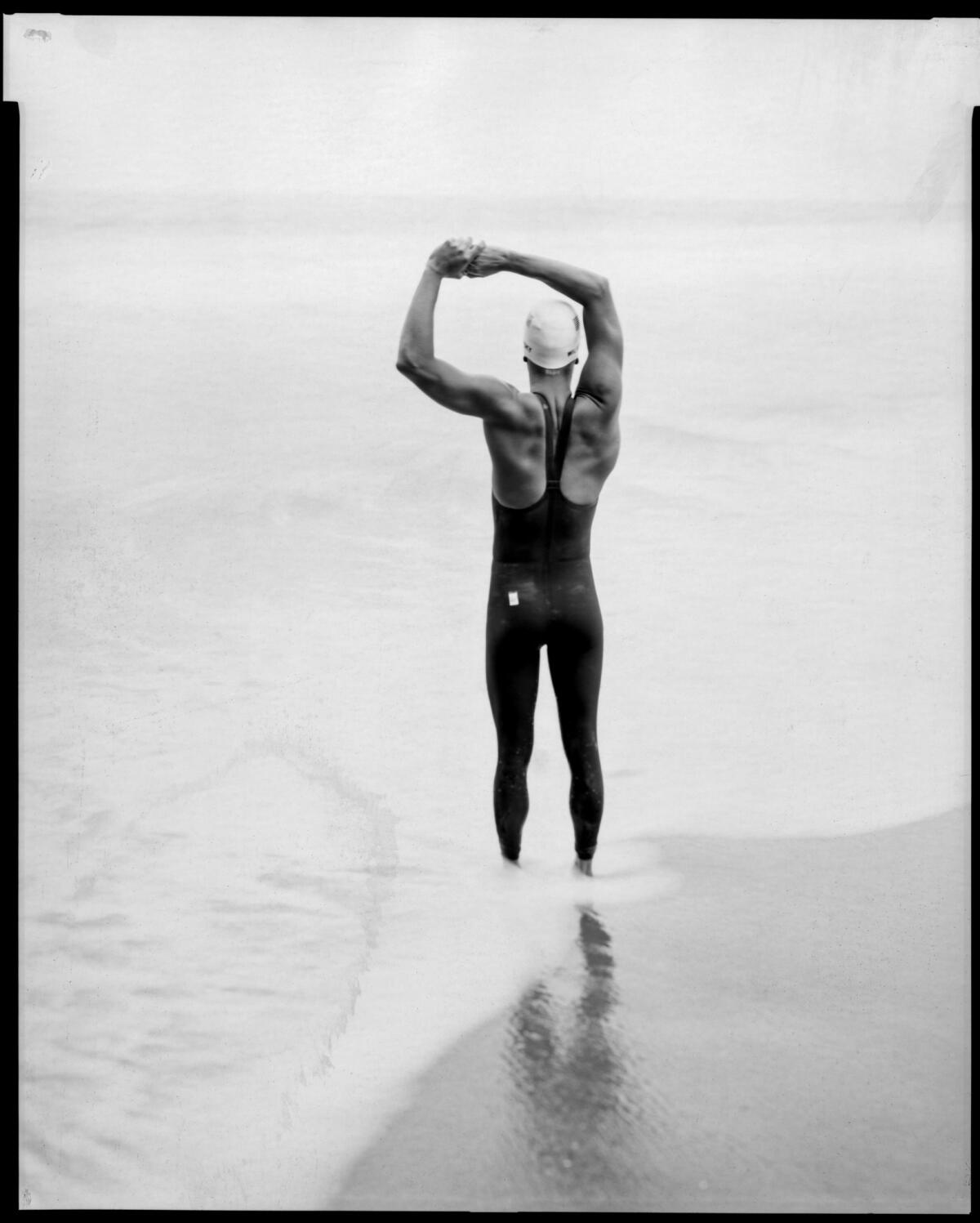
Jordan Wilimovsky
The first athlete I shot was open-water swimmer Jordan Wilimovsky, whom I had photographed for a daily sports section story and knew right away I’d want to have him be part of the Olympians series. Jordan is a great guy and was super easy to work with, so much so that I had to keep reminding him to tell me when he needed a break or warm towel. I had him meet me under the Santa Monica Pier, where I would ask him to stand in the water, motionless, while I made 15- to 20-second exposures with the 8-by-10 camera. The slow “film speed,” or ISO of paper, rating around 10, is why exposures are so long. Additionally, I am not bringing enough flash power to accommodate such a low ISO rating. The digital images were much easier to capture, as I was only shooting one to four seconds, with an ISO of 100 and using a flash (Profoto 7b, 1 head, w/warming gel) to stop any small motion of his body. After I felt like I had “something” from underneath (this is the huge advantage of digital), I moved us away from the pier and had Jordan stand in the crashing surf. Originally shooting him facing the camera, I switched to shooting him from behind after watching him turn and stretch between frames.
Setting aside the discipline and superiority as a competitor, one of the most admirable things about these athletes, for me, is the physical condition they are in. Showing Jordan’s back, one of the few parts of his visible body, was a goal, achieved by shooting from behind.
Courtney Mathewson
This was my third Olympics shooting a member of the women’s water polo team. For the first two, I went more traditional and made portraits of the athletes (Brenda Villa in 2008 and Tumua Anae in 2012) inside the pool. This year, with Courtney Mathewson, I incorporated water in the digital image, but didn’t have the benefit of the flash to stop water in the 8-by-10 exposure. Instead, I wanted to concentrate on a more dynamic portrait, utilizing shadow and highlight to my advantage, hopefully capturing the intense competitor I know Courtney to be.

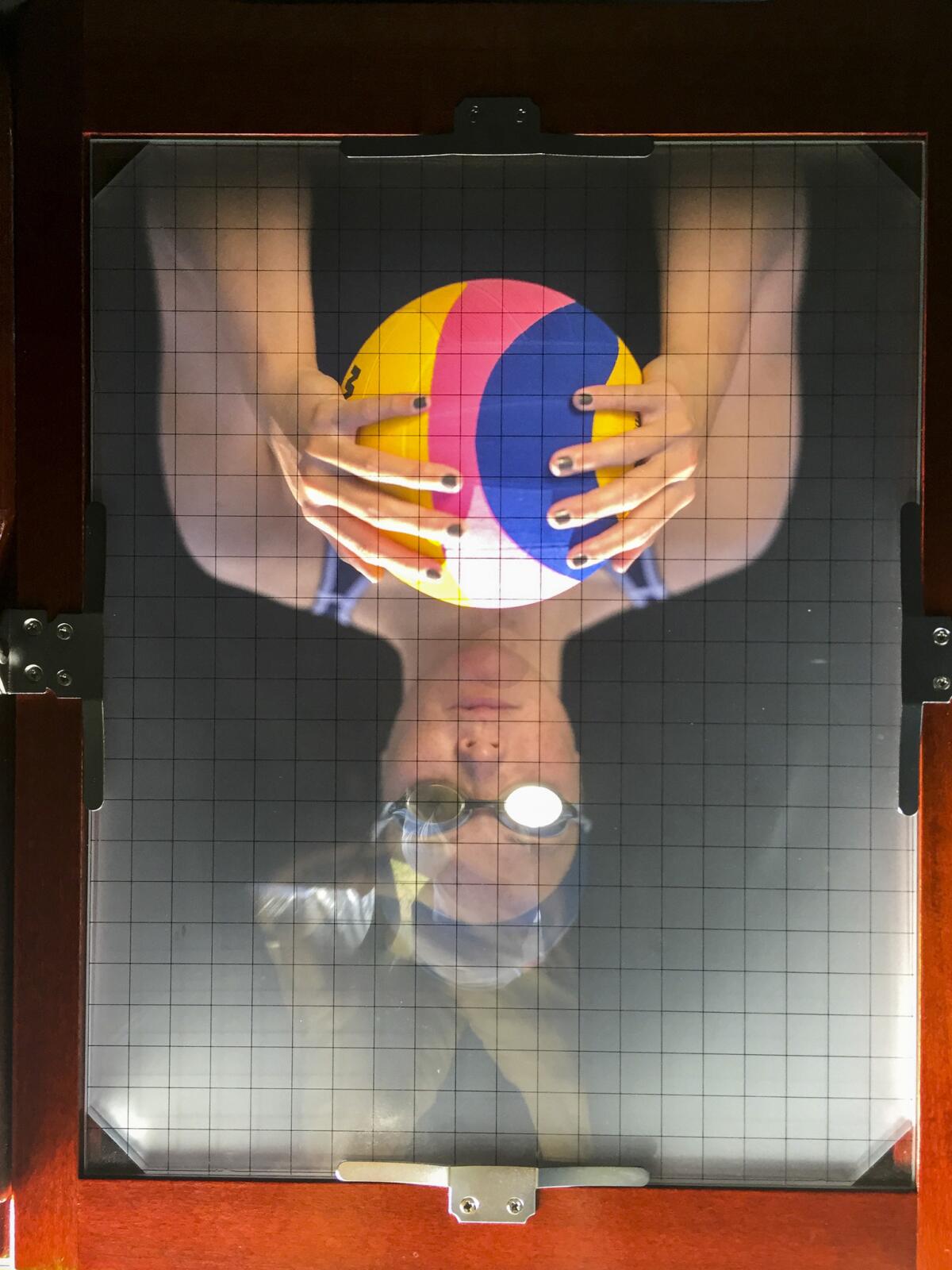

Carlos Balderas
I actually photographed boxer Carlos Balderas twice at his family’s boxing gym in Santa Maria. The first time, I tried hard to make the long exposures needed for the dimly lit space, but only one of my 12 frames was even close to usable. I ended up visiting Carlos a second time, on my way to San Francisco for another Olympian. I knew this second shoot would work, having chosen to shoot outside. I decided to drape him in a large U.S. flag, which worked out well, as a strong wind, combined with one- to three-second exposures, created a blurring of the flag. Carlos was a great subject, quickly turning on his intense “competitive” face and relaxing into his genuine smile after the shutter closed.
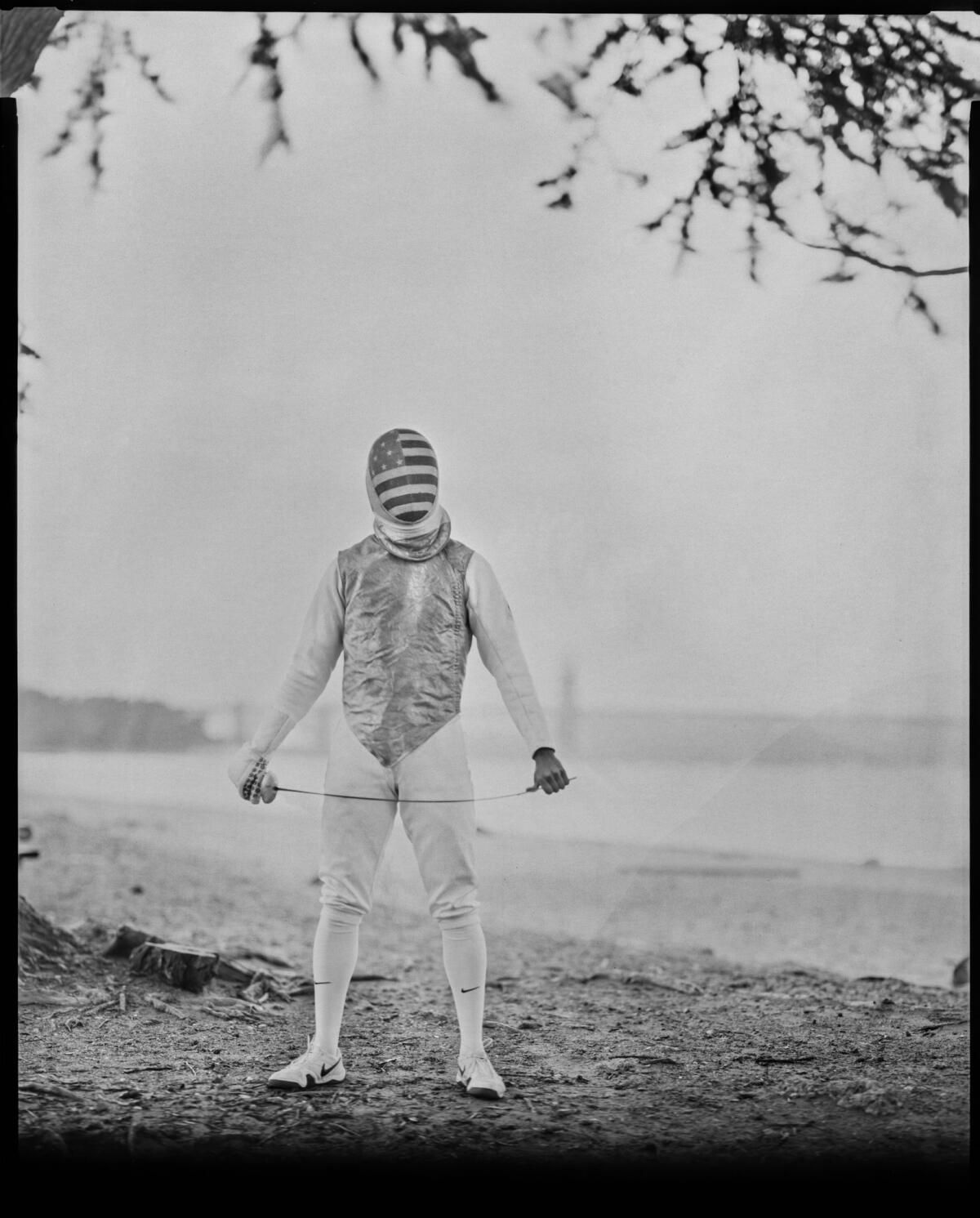
Alex Massialas
This was my second Olympics photographing Stanford fencer Alex Massialas. The son of a three-time Olympic fencer, Alex was as easy to photograph as an athlete can get. The first and largest hurdle, after driving more than six hours, was dealing with the unpredictable weather of the San Francisco Bay Area. I had picked out a spot for the portrait based on a previous visit, only to arrive and find the iconic Golden Gate Bridge hidden behind clouds. A Plan B quickly devolved all the way to Plan D, and we moved to a small portion of beach I knew about, with some tree coverage to help me deal with the light rainfall that had begun. Luckily, I was able to have a friend, Brian Churchwell, helping me push a cart full of gear down the walking path along Crissy Field. After setting up, testing, watching the bridge appear and disappear repeatedly over a two-hour period, I gave in to the fact that it wouldn’t be in my portrait. Having worked with me and my 4-by-5 film camera in 2012, Alex knew the drill and could repeat and hold a pose with no problem. In the end, his mask won again, with my favorite shot being him posing with his flag-covered mask and bent foil. As often goes, the sun fought its way through the clouds and the bridge started to reveal itself after Alex was gone and we were rolling back to the car. So goes living in the Bay Area, my friends later told me.
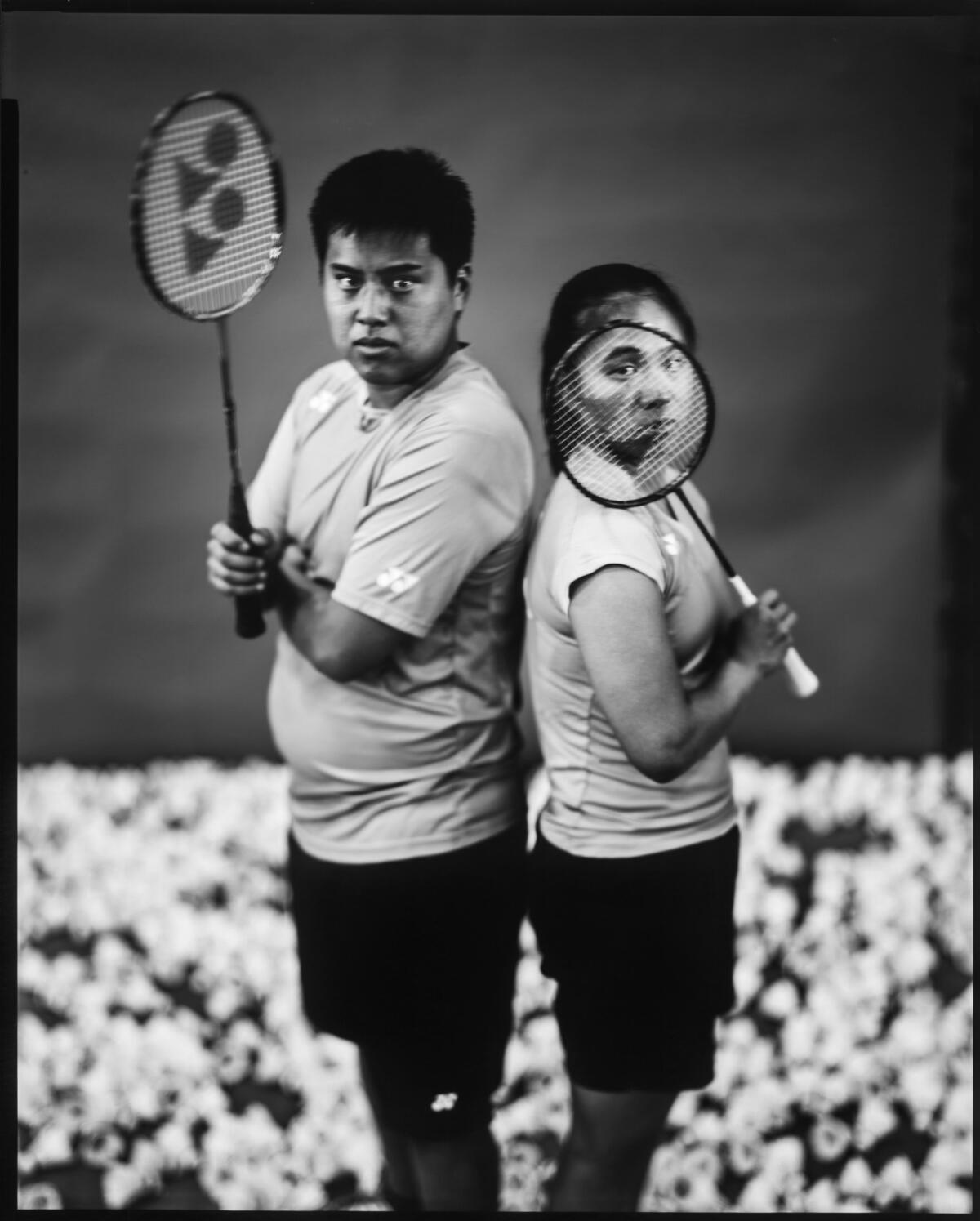
Badminton team
One of the many challenges of using the 8 by 10 is photographing more than one person in a frame. Part of the fun is being able to change the plane of focus with tilts and shifts of the camera’s lens. Unfortunately, when subjects, in particular their faces, are on different planes, getting both in focus is very difficult, and because I only have a short amount of time, I have to work to put the subject on the same plane. For Phillip Chew and Jamie Subandhi, who will compete on the U.S. badminton team, I posed them back-to-back and moved them until their faces were both in focus. As with Carlos, inside a dark boxing gym, I was up against slow shutter speeds, and this is why this image has a slight blur. I think the bit of motion adds to the “vintage” look of the black and white image, as well as some intensity from Phillip.
Kim Rhode
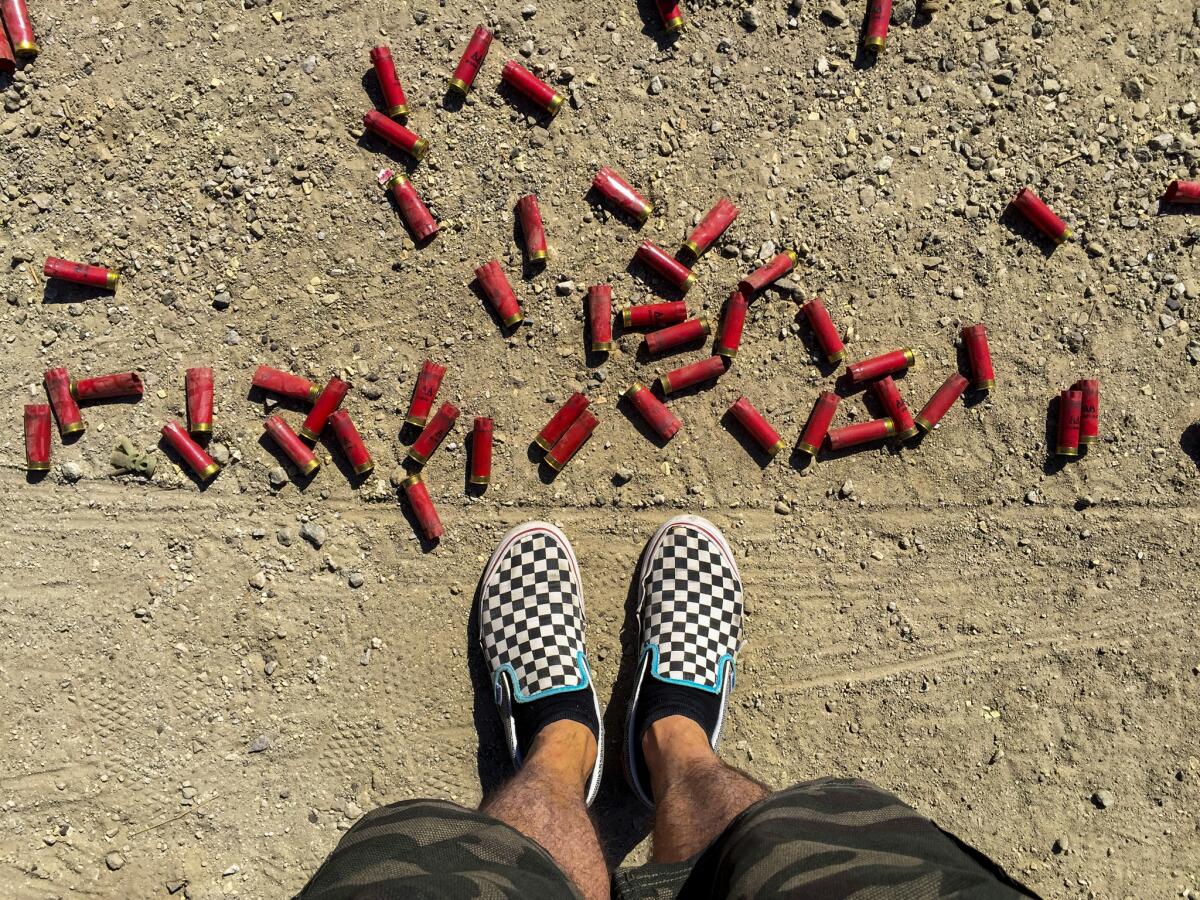
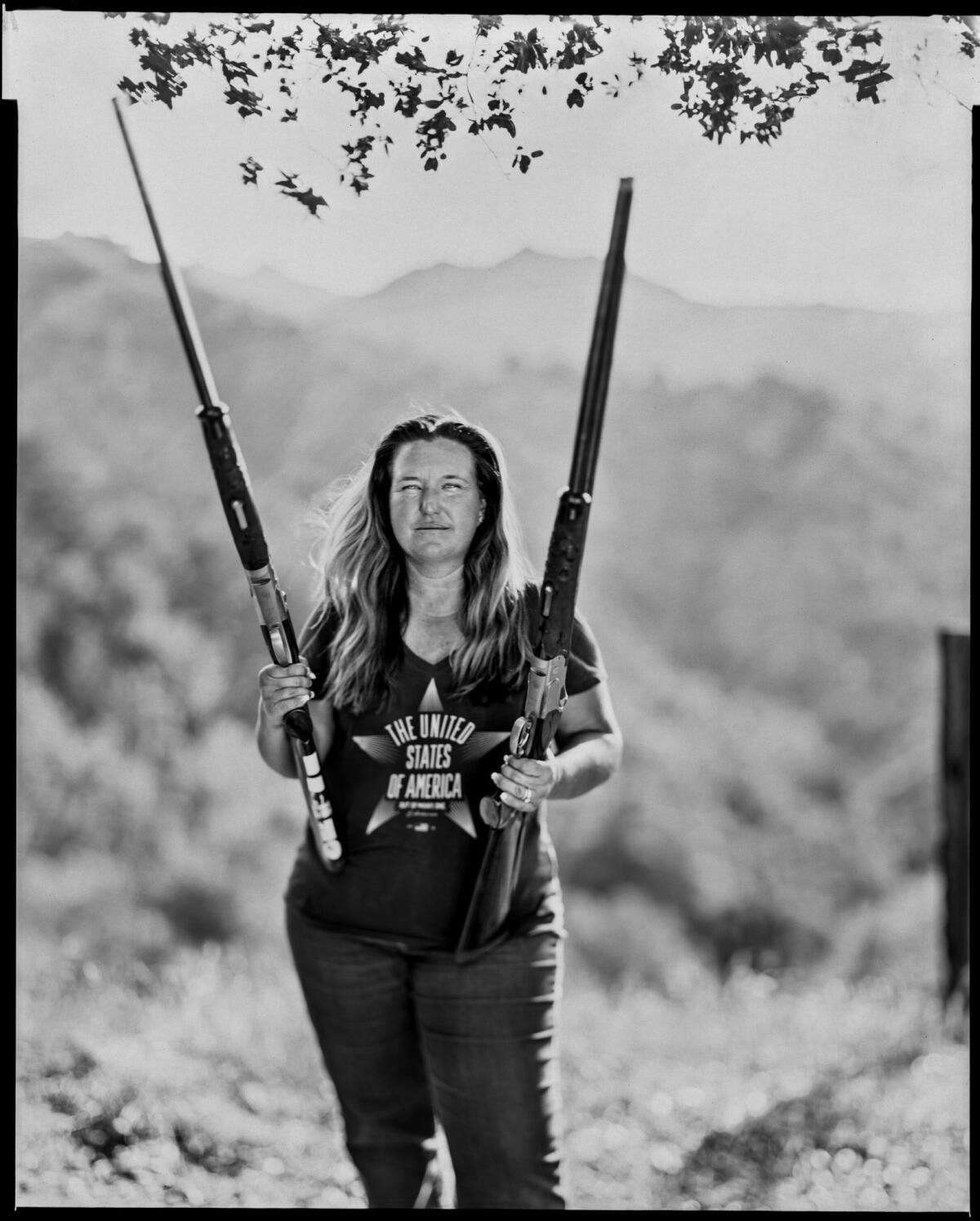
One of my favorite Olympians to work with, having included her each time I’ve done this portfolio, Kim Rhode will go after a sixth medal, this year in skeet. A win would make her the first Olympic athlete to medal in six consecutive Summer Games. She won her first medal, a gold, in Atlanta, in 1996. Kim and I discussed our previous collaborations, shooting (with camera and gun!) on the field of broken clay pigeons and decided to use a clean view of the Oak Tree Gun Club property in Newhall, settling on a peak, with a view of oak-covered hills.
Knowing the time she’s put into becoming one of the best in the world (27 years shooting), I wanted to show the confident athlete Kim is, photographing her casually holding the two guns she’ll take with her to Rio.
Rugby Men
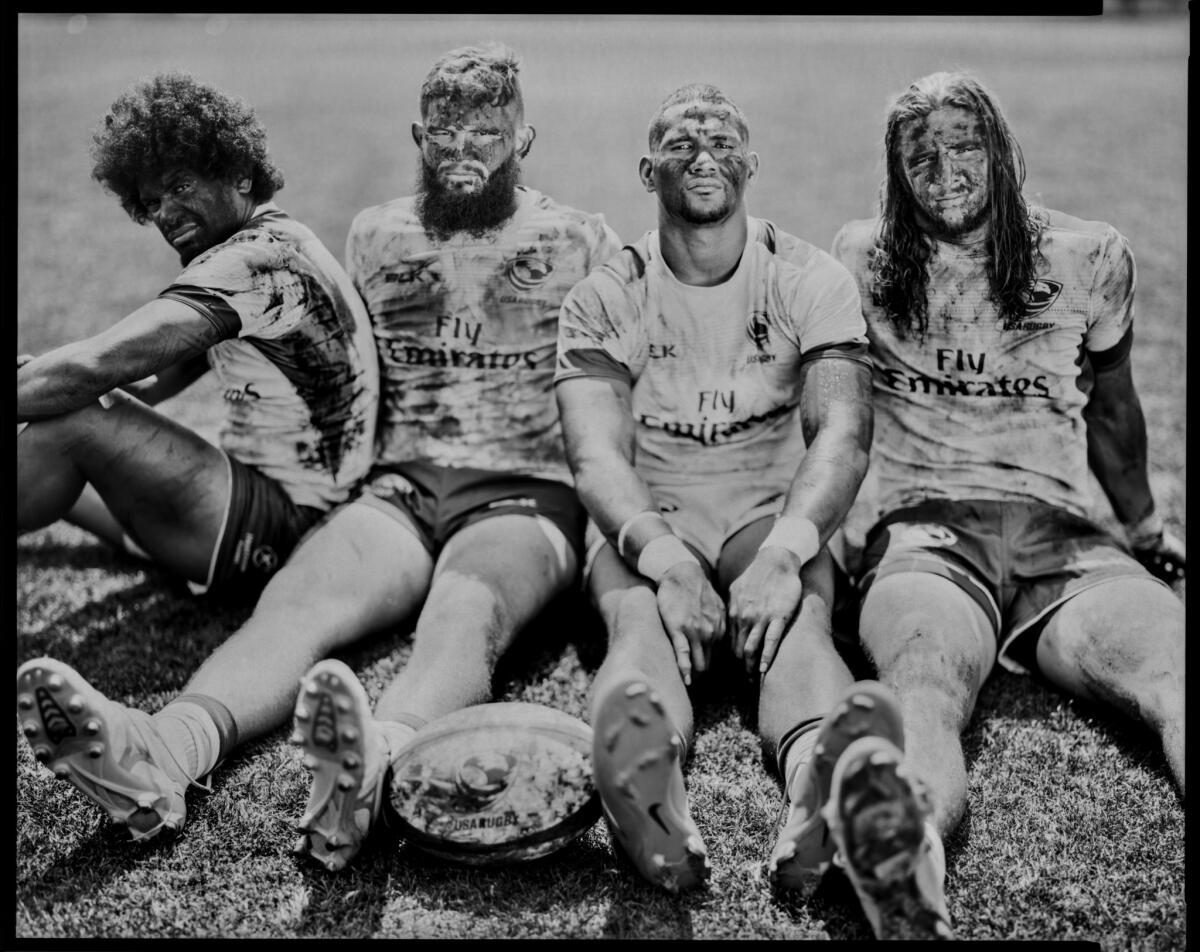
One of my favorite and messiest Olympian portraits was of four members of the men’s rugby team. The sport hasn’t been seen at the Olympics since the U.S. won the gold in 1924, and this is the first Olympic appearance for rugby sevens, with smaller teams. I gathered four members of the team, Folau Niua, Danny Berret, Martin Iosefo and Garrett Bender and proceeded to cover them in mud. We had to “make” the mud, as the fields of U.S. Olympic Training Center in Chula Vista are kept in pristine condition and I wasn’t allowed to muddy them. I knew I wanted to make a portrait that would illustrate the dedication and intensity of these athletes and their love of this sport. Having watched a couple of games online, I knew these guys were real-deal gladiators, but their smiles and laughter, between frames of mud-covered intensity, revealed their oversized teddy bear personalities.
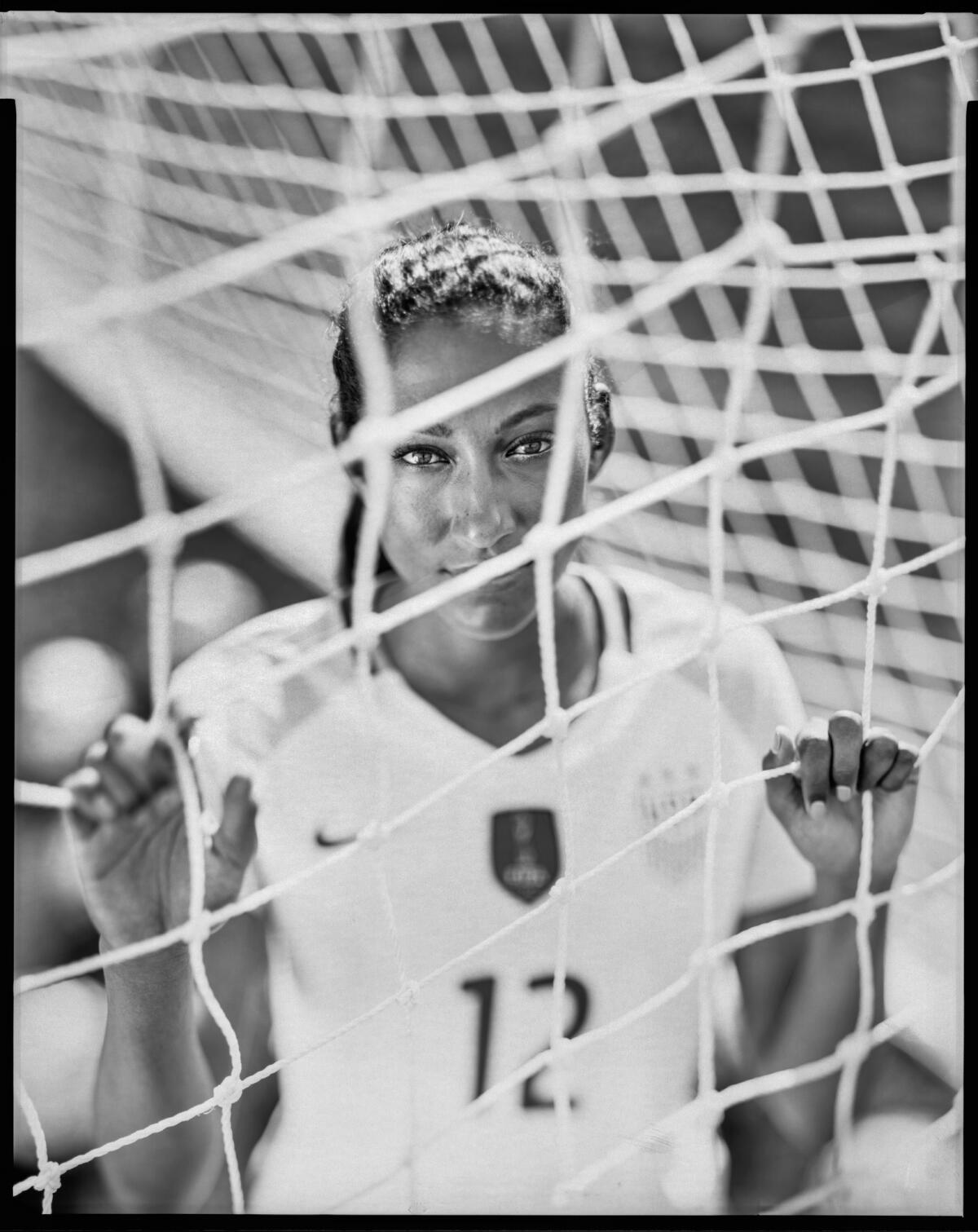
Christen Press
A southern California native, Christen Press is a force of nature in women’s soccer. I was able to catch Christen during a break in traveling and photograph her on the campus of Chadwick School in Palos Verdes, where she graduated in 2007.

A natural in front of the camera, Christen was one of my quickest shoots, finding and holding poses instinctively. Her eyes stood out in every frame, in both black and white and color. The hardest part of making portraits with Christen was the white uniform, but since it was her official kit, I let it slide!
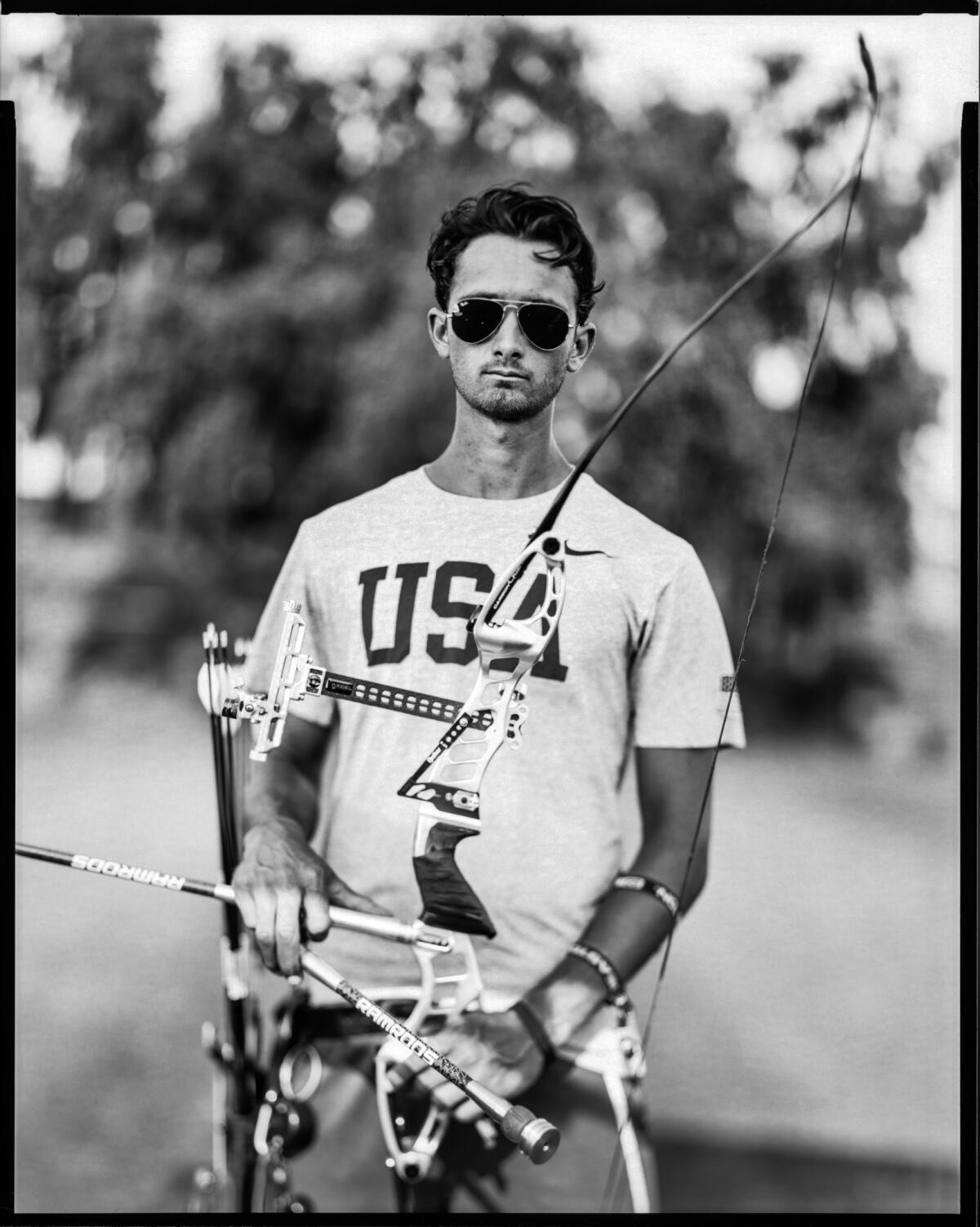
Zach Garrett
While at the Olympic center in Chula Vista, I was also able to photograph archer Zach Garrett between training sessions. Zach, 21, had his first formal competition through 4-H at age 8 and became pretty serious by the time he was 14. He graduated high school in Wellington, Mo., in 2013, and has been living at the training center ever since, living and breathing his archery training and competition. He was on his afternoon break, walking over to us from his dorm, positioned across a driveway along the archery field. Zach exuded “cool,” holding his carbon-fiber appointed bow and USA t-shirt. A genuinely nice guy, Zach was a great sport, in great physical condition, holding the drawn bow for minutes at a time. He reminded me of a character Tom Cruise might play, sunglasses and all.
Working on the Olympians wasn’t a completely retro experience. We are in a digital world and I was also carrying current camera gear. In addition to my Canon EOS 5DS R and 24-70mm f/2.8L II USM, I was lucky enough to be loaned a Nikon D810 camera and the Nikon PC-E Micro-NIKKOR 45mm f/2.8D ED Tilt-Shift Lens. This Nikon combination was incredible, with a full-frame chip (like my Canon) and a top-of-the-line technology-wise tilt-shift, which I have utilized in my portrait work for years.

Getting this project booked was no easy task. Starting with a list of about 15 athletes, through scheduling conflicts and travel, I ended up photographing nine subjects. From Chula Vista (men’s rugby team and archer Zach Garrett) to San Francisco (fencer Alexander Massialas), I dragged all my gear — and several times, our summer photo interns — on one of my favorite assignments I do for the L.A. Times. A huge thanks to all our athletes and those that help me do what I do, in particular Suzette Moyer, for her faith in me to keep Bruce’s voice in my ear, pushing me to do more and go bigger.
Go beyond the scoreboard
Get the latest on L.A.'s teams in the daily Sports Report newsletter.
You may occasionally receive promotional content from the Los Angeles Times.




